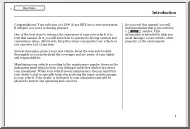Please log in to read this in our online viewer!

Please log in to read this in our online viewer!
No comments yet. You can be the first!
What did others read after this?
Content extract
Definition of root, nth root, Identities Square root of a non-negative real number ’a’ (a≥0) is a unique non-negative number (√a) whose square is ‘a’ a≥0 and √a≥0 √a2 = a (a2 is always a non-negative number) The absolute value of a real number ‘a’ is a = ‘a’, when a≥0 ‘-a’, when a<0 Nth root For any positive even ‘n’ and non-negative ‘a’ n√a is a non-negative real number whose nth power is ‘a’. For any even ‘n’ and negative ‘a’, the nth root is undefined, since the power of any real number with even exponent is always non-negative. For any odd ‘a’ (n>1), n√a is a real number whose nth power is ‘a’. 3 4 √27=3 √256=4 5 √-32=-2 Nth root of a power a. n √a*b=n√a n√b n>1 and ‘n’ is an integer - if ‘n’ is even ‘a’ and ‘b’ are non-negative real numbers. - if ‘n’ is odd ‘a’ and ‘b’ are arbitrary real numbers. Proof n √a*b = n√a n√b /raising to the nth
power by definition the left side is a * b nth power of the right side: (n√a * n√b)n = (n√a)n (n√b)n = a b - if ‘n’ is odd and the nth power of the two sides of the equation are equal, then the two sides are equal if ‘n’ is even and both sides of the equation are non-negative and the nth power of the two sides of the equation are equal, then the two sides of the equation are equal. The nth root of a quotient n√a/b = n√a/n√b, where n>1 and ‘n’ is an integer - if ‘n’ is even ‘a‘ is a non-negative real number, while ‘b’ is a positive real number. If ‘n’ is odd ‘a’ and ‘b’ are arbitrary real numbers, b ≠0. Proof n√a/b = n√a/n√b / raising to the nth power by definition the nth power of the left side is a/b nth power of the right side: (n√a/n√b)n = (n√a)n / (n√b)n = a/b The nth power of a quotient is equal to the quotient of the nth powers of the numerator and the denominator. - if ‘n’ is odd and
the nth power of thw two sides of the equation are equal then the two sides of the equation are equal. If ‘n’ is even and both sides of the equation are non-negative and the nth powers of the two sides of the equation are equal the two sides of the equation are equal. Root of a power (k√a)n = k√an, where k>1 and ‘k’ is an integer and n>1 and ‘n’ is an integer. - if ‘k’ is odd, then ‘a’ is an arbitrary real number if ‘k’ is an even number, then ‘a’ is a non-negative real number. Proof k √an = k√(a * a . * a) = k√a k√a k√a = (k√a)n └―――――――┘ n times - - we used the identity of the root of a product to find the root of a power first find the root, then raise to power. Properties of x√x function - D is R+ including 0 R is R+ including 0 Zero at x=0 X intercept: x=0 Y intercept y=0 smi function no max min at x=0 with value 0. Note: if ‘n’ is odd, the Domain and the Range of the function are R.
Applications: - Hero’s formula - Quadratic formula - Compound interest
power by definition the left side is a * b nth power of the right side: (n√a * n√b)n = (n√a)n (n√b)n = a b - if ‘n’ is odd and the nth power of the two sides of the equation are equal, then the two sides are equal if ‘n’ is even and both sides of the equation are non-negative and the nth power of the two sides of the equation are equal, then the two sides of the equation are equal. The nth root of a quotient n√a/b = n√a/n√b, where n>1 and ‘n’ is an integer - if ‘n’ is even ‘a‘ is a non-negative real number, while ‘b’ is a positive real number. If ‘n’ is odd ‘a’ and ‘b’ are arbitrary real numbers, b ≠0. Proof n√a/b = n√a/n√b / raising to the nth power by definition the nth power of the left side is a/b nth power of the right side: (n√a/n√b)n = (n√a)n / (n√b)n = a/b The nth power of a quotient is equal to the quotient of the nth powers of the numerator and the denominator. - if ‘n’ is odd and
the nth power of thw two sides of the equation are equal then the two sides of the equation are equal. If ‘n’ is even and both sides of the equation are non-negative and the nth powers of the two sides of the equation are equal the two sides of the equation are equal. Root of a power (k√a)n = k√an, where k>1 and ‘k’ is an integer and n>1 and ‘n’ is an integer. - if ‘k’ is odd, then ‘a’ is an arbitrary real number if ‘k’ is an even number, then ‘a’ is a non-negative real number. Proof k √an = k√(a * a . * a) = k√a k√a k√a = (k√a)n └―――――――┘ n times - - we used the identity of the root of a product to find the root of a power first find the root, then raise to power. Properties of x√x function - D is R+ including 0 R is R+ including 0 Zero at x=0 X intercept: x=0 Y intercept y=0 smi function no max min at x=0 with value 0. Note: if ‘n’ is odd, the Domain and the Range of the function are R.
Applications: - Hero’s formula - Quadratic formula - Compound interest




